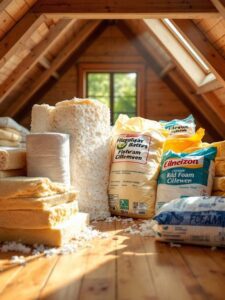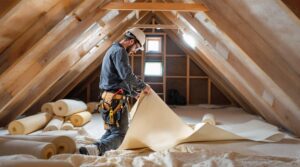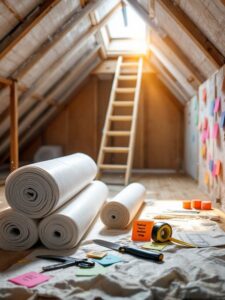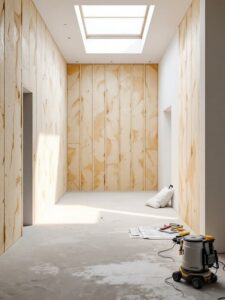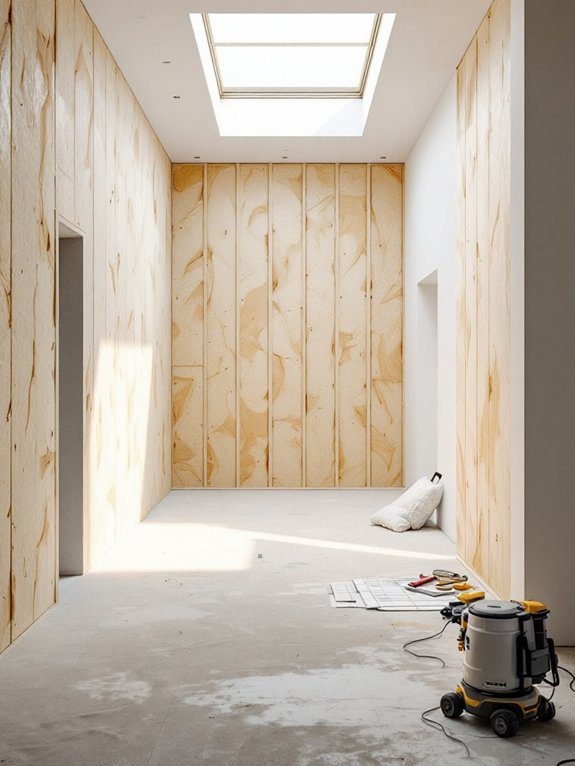External wall insulation systems combine multiple protective layers to dramatically improve your home's thermal performance and weather resistance. You'll benefit from a 25-35% reduction in heating costs through EPS, mineral wool, or phenolic foam insulation materials, properly secured with mechanical fixings and reinforcement mesh. Professional installation costs between $8,000-$15,000, with ROI achieved in 7-10 years through energy savings and increased property value. The all-encompassing system's effectiveness depends on precise installation methods and ongoing maintenance strategies.
Key Takeaways
- External wall insulation systems combine insulation materials with weatherproof finishes to protect homes from heat loss and weather damage.
- Installation costs between $8,000-$15,000 but delivers 25-35% reduction in heating costs and increases property value by 5-10%.
- The system requires multiple layers: adhesive base coat, insulation board, mechanical fixings, reinforcement mesh, and weather-resistant finish.
- Choose between EPS for cost-effectiveness, mineral wool for fire resistance, or phenolic foam for maximum thermal efficiency.
- Regular maintenance includes biannual inspections, prompt repairs of damage, and annual cleaning to ensure long-term performance.
Understanding External Wall Insulation Systems

External Wall Insulation (EWI) systems consist of multiple layers working together to create a thermally efficient building envelope.
You'll find these systems typically include an adhesive base coat, your chosen insulation material, mechanical fixings, reinforcement mesh, and a weather-resistant finish.
When selecting from various types of insulation, you'll need to evaluate options like expanded polystyrene (EPS), mineral wool, or phenolic foam boards.
Each insulation material offers distinct benefits: EPS provides excellent thermal performance at a lower cost, mineral wool delivers superior fire resistance and soundproofing, while phenolic foam offers the highest thermal rating per thickness.
Your system's effectiveness depends on proper installation of each component, ensuring they work as a unified barrier against heat loss and weather infiltration.
Benefits of Combined Insulation and Weatherproofing
Building on the multi-layered approach of EWI systems, combining insulation with weatherproofing delivers significant dual advantages for your home's thermal and structural performance.
You'll benefit from enhanced thermal performance through reduced heat loss while simultaneously protecting your walls from moisture penetration and weather damage.
Cost Analysis and Return on Investment

Three key financial factors determine the return on investment for EWI installation: initial costs, energy savings, and property value appreciation.
You'll need to budget between $8,000 to $15,000 for a typical home installation, depending on your property's size and chosen materials.
Your investment returns typically manifest through a 25-35% reduction in heating costs annually, translating to $300-500 savings per year in most climates.
Property value appreciation adds another 5-10% to your home's market worth.
When calculating your break-even point, factor in current energy prices and potential government incentives.
Most homeowners recover their initial investment within 7-10 years through reduced energy bills alone.
Your local climate notably impacts these budget considerations – colder regions see faster returns due to greater heating cost reductions.
Installation Process and Best Practices
When planning your external wall insulation project, successful installation requires meticulous preparation and adherence to industry standards.
You'll need to guarantee proper installation techniques are followed to maximize energy efficiency and durability. Safety precautions must be your top priority throughout the process, including proper scaffolding setup and protective equipment use.
- Prepare your walls by removing loose materials, repairing cracks, and confirming the surface is clean and dry before applying any insulation materials.
- Install mechanical fixings at manufacturer-specified intervals, confirming proper depth and distribution to support the insulation boards effectively.
- Apply base coat, reinforcement mesh, and finishing render in ideal weather conditions, maintaining consistent thickness and allowing adequate drying time between layers.
Remember to document each step and maintain quality control checks throughout the installation process to achieve professional results.
Weather Protection Techniques and Materials

Following proper installation, your home's external walls need robust weather protection to maintain their insulation effectiveness.
You'll want to start with high-grade weather resistant membranes that create a protective shield against wind-driven rain and moisture infiltration. These membranes work alongside moisture barriers to establish a thorough defense system.
For maximum protection, you'll need to incorporate a ventilated cavity between your insulation and exterior cladding. This allows any trapped moisture to escape while preventing water from reaching the insulation layer.
Select materials rated for your climate zone – silicone-based sealants for joints, UV-resistant barriers for sun exposure, and vapor-permeable membranes for areas with high humidity.
When properly integrated, these protective layers work together to safeguard your investment and maintain your home's thermal efficiency.
Common Challenges and Solutions
Despite careful planning, external wall insulation projects often face several technical hurdles that require specific solutions.
You'll encounter various installation challenges, but with proper preparation and professional guidance, you can effectively address these issues.
- When dealing with uneven wall surfaces, you'll need to apply leveling compounds or install mounting rails to create a uniform base for insulation panels.
- To combat moisture issues, guarantee proper ventilation gaps and install specialized vapor barriers. This prevents condensation buildup between your walls and insulation material.
- If you're working around windows and doors, use appropriate edge beading and specialized corner pieces to maintain insulation continuity while preventing water ingress at these vulnerable points.
Energy Efficiency Improvements and Savings

Once properly installed, external wall insulation can dramatically reduce your home's energy consumption by up to 45%.
You'll notice immediate improvements in both heating and cooling efficiency, as your HVAC system won't need to work as hard to maintain comfortable temperatures.
To maximize your savings, start with professional energy audits to identify specific areas where you're losing heat.
Many local authorities offer insulation grants to help offset installation costs, making this investment more accessible for homeowners like you.
You'll typically see returns through reduced energy bills within 3-5 years.
The insulation's effectiveness can be monitored through your monthly utility bills, with most households reporting 30-40% reductions in their energy costs.
These savings continue to accumulate year after year, making external wall insulation a smart long-term investment.
Maintenance and Long-Term Care
While external wall insulation requires minimal upkeep, regular inspections will help maintain its effectiveness and extend its lifespan.
You'll want to establish a routine inspection schedule to check for any damage, moisture penetration, or signs of deterioration. When issues are caught early, repair techniques can be simpler and more cost-effective.
- Perform visual inspections every six months, paying special attention to joints, seals, and areas around windows and doors.
- Address any cracks, chips, or damage immediately using manufacturer-approved repair techniques to prevent moisture infiltration.
- Clean surfaces annually using gentle pressure washing to remove dirt and debris without damaging the insulation system.
If you're unsure about performing maintenance tasks yourself, don't hesitate to contact a qualified professional. They'll help make certain your insulation system continues functioning effectively for years to come.
Frequently Asked Questions
Can External Wall Insulation Affect the Resale Value of My Home?
You'll likely see increased resale value since exterior insulation boosts your property appeal. Buyers appreciate energy efficiency and lower utility costs, making your home more competitive in today's market where sustainability matters.
Is It Possible to Install Security Cameras After External Wall Insulation?
Don't worry about damaging your insulation! You can definitely install security cameras through your external wall insulation. Just use special mounting brackets and weatherproof fittings designed for insulated walls to guarantee proper security camera installation.
How Does External Wall Insulation Impact Indoor Cell Phone Reception?
You'll likely notice some signal interference with your cell reception since insulation materials can block radio waves. Consider installing a signal booster or using Wi-Fi calling to maintain strong connectivity inside your home.
Will External Wall Insulation Change the Architectural Character of My Period Home?
Yes, it'll alter your home's appearance, but proper design considerations can minimize visual impact. You can work with specialists in historical preservation to select finishes and textures that respect your property's original architectural character.
Can I Grow Climbing Plants on Walls With External Insulation?
Ever dreamed of a green façade? You'll need special fixings that penetrate through your insulation to secure climbing plants. Choose compatible support systems that won't compromise the insulation's performance while supporting your botanical ambitions.
Conclusion
Just as a sturdy shield protects a warrior, your newly insulated and weatherproofed exterior walls now stand guard against nature's assault. You'll witness your home's transformation into an energy-efficient fortress, deflecting cold, heat, and moisture while maintaining ideal interior conditions. By implementing these technical solutions, you've created a defensive system that'll consistently deliver measurable savings and superior comfort for years to come.

